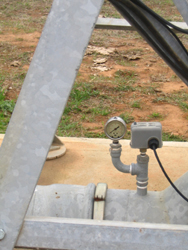4.2.2.4 - What pressure does the system need?
Return to Main Menu | Return to Step 4 | Return to Step 4.2.2 | Next Step
Individual systems vary considerably. It is desirable and often practical to achieve pivot centre pressures of no more than 18 m (25 psi).
Many sprinklers operate efficiently at 7 m (10 psi), or even less. There is no advantage in operating sprinklers at pressures higher than needed for efficient operation.
Span-pipe headloss may be greater than 7 m (10 psi), particularly on a long, high application-rate pivot. It may not be economical to size the pipe large enough to keep headloss to 7 m (10 psi). Similarly, the mainline and suction headloss will vary depending on the pipe size chosen. For more details see Step 4.2.3.3 “The trade-off between capital and operating costs”.

Pressure gauge at pivot centre
Page top
| The total head that the pump operates against is directly related to the cost of operating the system, so it is desirable to minimise the head as far as practicable. “Head” is a term that includes pressure and elevation. “Head loss” is the loss of head or pressure that occurs, for example, as a result of friction in a pipe. The total head includes the pressure that the sprinklers and regulators operate at, head loss along the span-pipe, head loss in the supply mainline and suction pipe, and the elevation difference between the water supply and the highest part of the irrigated area. Head is commonly expressed as metres (m) of water (the pressure of a column of water), kilopascals (kPa) or in imperial units, pounds per square inch (psi). A typical system may have a total head of 35 m (50 psi), composed of: |
- | Pressure at sprinkler | 14 m | (20 psi) |
- | Regulator headloss | 3.5 m | (5 psi) |
| Span-pipe headloss | 7 m | (10 psi) | |
| Pressure at pivot centre (sub-total) | 24.5 m | (35 psi) | |
- | Mainline, suction, fittings headloss | 8 m | (11 psi) |
- | Elevation difference | 3 m | (4 psi) |
| Total | 35.5 m | (50 psi) |
Individual systems vary considerably. It is desirable and often practical to achieve pivot centre pressures of no more than 18 m (25 psi).
Many sprinklers operate efficiently at 7 m (10 psi), or even less. There is no advantage in operating sprinklers at pressures higher than needed for efficient operation.
Span-pipe headloss may be greater than 7 m (10 psi), particularly on a long, high application-rate pivot. It may not be economical to size the pipe large enough to keep headloss to 7 m (10 psi). Similarly, the mainline and suction headloss will vary depending on the pipe size chosen. For more details see Step 4.2.3.3 “The trade-off between capital and operating costs”.

Pressure gauge at pivot centre


